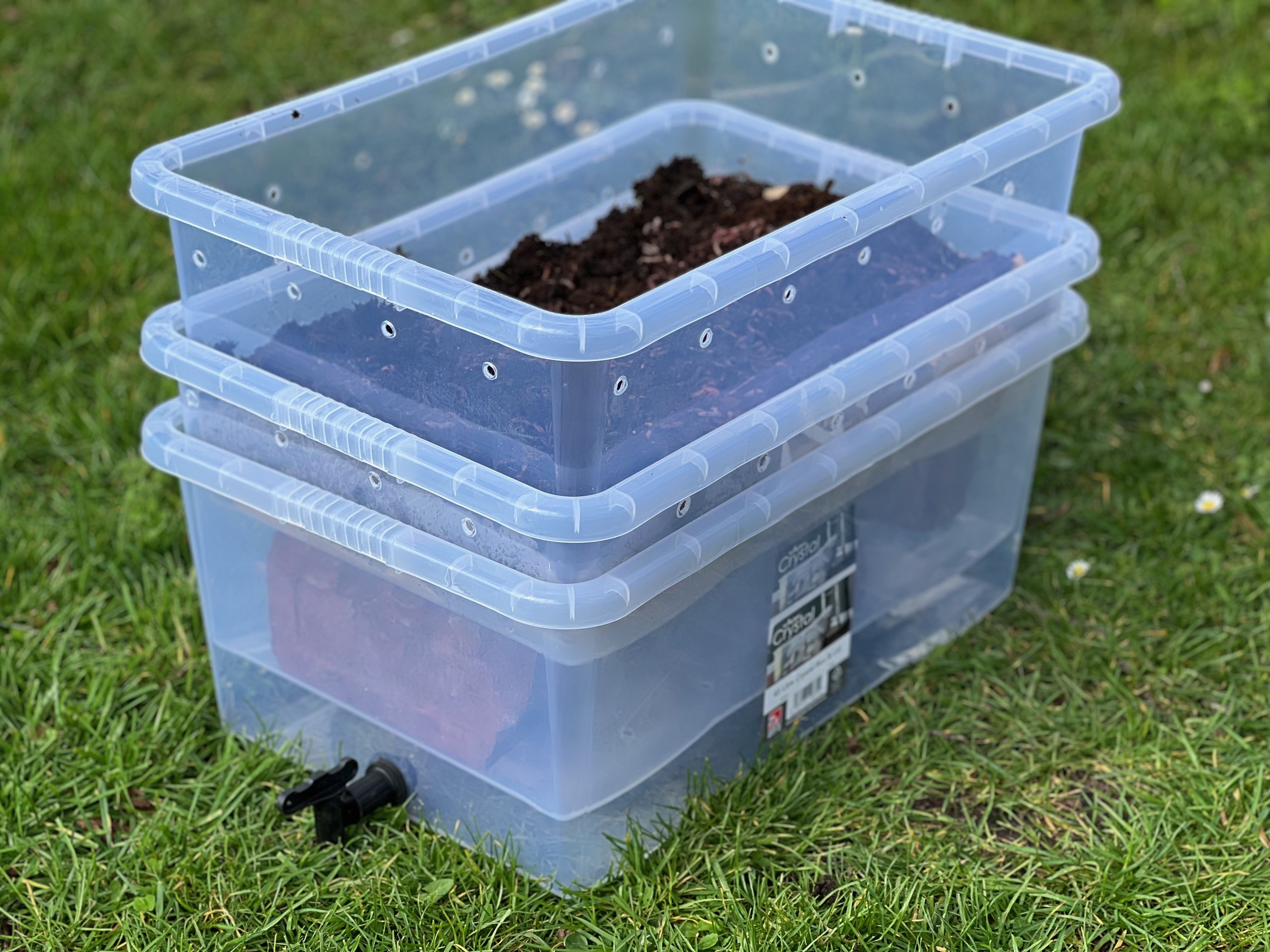We built a wormery
Because we’re growing flowers sustainably, we’re always on the lookout for ways to give back to and improve our soil. We’ve been making our own general compost for a while, but one thing we haven’t tried yet, that lots of people rave about, is making worm compost or worm castings. And for that you need a wormery. You can buy a ready made wormery for around £100, but that’s not in the budget, so we made our own. Here’s what we did.
What is a wormery?
A wormery or worm bin has a series of compartments or boxes, ideally at least three.
A bottom box to collect liquid.
A top box where the worms live. This is where your kitchen waste - their food - goes.
And a spare middle box.
Once the top tray is full, the idea is you move the empty middle box to the top, add more kitchen waste, and the worms move up into it. You can then use all the lovely worm compost left behind in the other box.
What’s good about worm compost?
The compost produced by worms is generally rich in nitrogen and potassium. This makes it a great soil conditioner - you can just spread a little onto the soil where the roots go into the ground 2-3 times a year - and a great addition to potting mixes to give plants a boost of nutrition. Use it in a 1:4 ratio with your compost mix.
The liquid or ‘worm tea’ that drains to the bottom of a wormery can also be used as liquid fertiliser diluted one part to 10 parts water. It has lots of nutrients and enzymes that promote growth and help plants build resistance to pests.
What worms can you use for your wormery?
Your normal garden worm is no good for a wormery. They love burrowing into the soil.
Instead you need composting worms. These are red, smaller, live at the surface of the soil and love decaying matter. You can use Tiger or Brandling worms Eisenia fetida or European nightcrawler Dendrobaena, or even a mix.
There are lots of suppliers. We got ours from wormsdirectuk.co.uk.
How many worms will I need?
This depends on the size of your wormery. The more worms you have, the faster they’ll work through your kitchen waste.
We’re starting with about 250g – roughly 500 - mixed worms that cost around £15.
They should double their population every three months but the will only continue to reproduce if there is enough food supply.
How to build a wormery?
You will need three trays that can stack on top of each other. The top one will need a lid.
The larger the surface area, the more food waste you can feed it. We’re using boxes that are roughly 60cm long x 40cm wide x 25cm high.
On two boxes, drill 0.5-1.2cm holes in the bottom about every 8cms, and then a single row of 0.5cm holes around the top, again about every 8cm.
The ones in the bottom allow liquid to seep down, and the worms to move up. The ones around the top are to let air circulate.
Put a tap in the bottom of the last box, but no other holes. This one is for the liquid that drains from the boxes above.
If you haven’t got a tap, you can just empty this box manually.
Put two bricks in, then stack a box with holes on top.
Put two bricks in, then stack the other box with holes on top.
In this top box, place a layer of damp newspaper, then about 3-8cm of bedding material for the worms to burrow in.
Old, warm, moistened compost or warm, moist coconut coir are good. Getting and using some worm compost that already contains the micro life they need is better still.
Add the composting worms, spreading them out over the bedding
You can cover this with a layer of damp newspaper to keep it warmer and deter flies.
Put the lid on the top box.
Feeding your worms
Give them about a week to settle in then add a layer of kitchen waste.
Chop the waste into small pieces so it’s easier and faster to eat.
Some people bury it into the compost layer thinking that helps prevents flies.
While worms can eat their body weight in a day, avoid adding too much waste, or it can start to rot and smell before the worms have had time to work through it.
If the waste hasn’t been eaten in a few days, stop feeding until the worms work their way through.
Add some water if the wormery starts looking dry.
Every so often, fork through the compost to check the worms are still there.
When the top box is full, switch it with the middle box, add a little compost and carry on adding kitchen waste.
The worms will migrate into the top box and you can use the worm compost left behind in the middle box on the garden.
If you don’t have a top tray, you’ll need to scoop off the top 20cm of soil with the worms in, remove and use what’s left and then add the worms back. And the whole process starts again.
What kitchen waste can I use in my wormery?
You can use
Raw or cooked vegetables, but not onions, garlic or leeks
Fruit, banana skins
Tea bags and coffee grounds
Eggshells
Small amounts of shredded paper, but nothing glossy
You should not use
Citrus peel
Dairy products
Meat or fish
Tough woody material
Where should I keep my wormery?
Worms like warm, moist conditions. They don’t like to be waterlogged or cold. Their activity apparently declines once temperatures drop below 10 degrees Celsius. If they’re somewhere that gets very cold, you’ll need to wrap your wormery with something to stop it freezing.
Nor do they want to be in direct sun.
They can smell and attract flies, so not sure you want them in the house.
We started our wormery in the spring, when the weather started warming up, and are keeping it next to our lean-to greenhouse.
How long does worm compost take to produce?
It will take two to three months for worms to turn kitchen waste into compost.
Any liquid should seep down to the bottom tray and should be regularly drained off from there. Place the box with no holes onto two bricks, so you can put something under the tap and drain the liquid out.
How long can I leave my wormery for?
You should be able to leave your wormery without adding food for up to four weeks.
What problems should I look out for?
Back, sludgy compost, worms dying: There is not enough oxygen, the soil is too wet and/or the wrong waste has been added eg too much citrus.
In summary
So, a free way of getting rid of kitchen scraps while making something great for your soil, but more worryingly, another thing for us to worry about killing!
Bulb to Bunch | Beautiful, locally grown flowers, reminiscent of an English country garden, available as bouquets, in buckets and wholesale.
www.bulbtobunch.com







